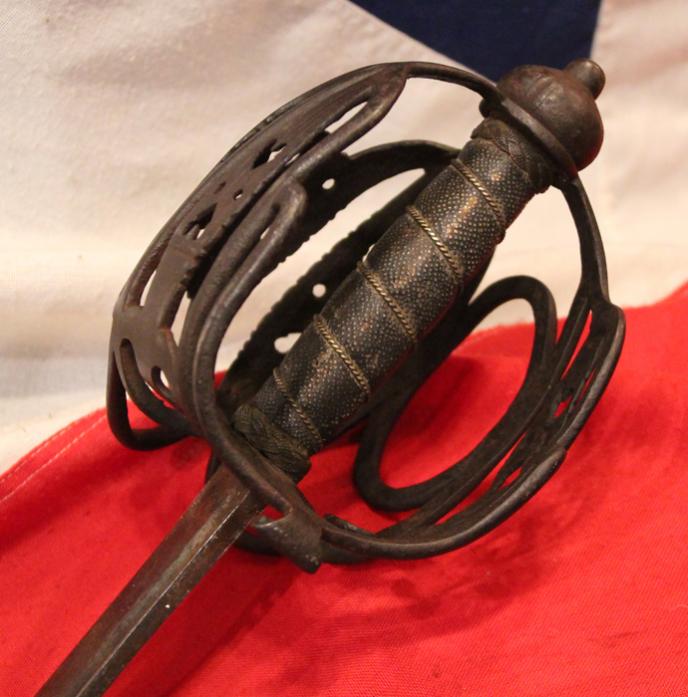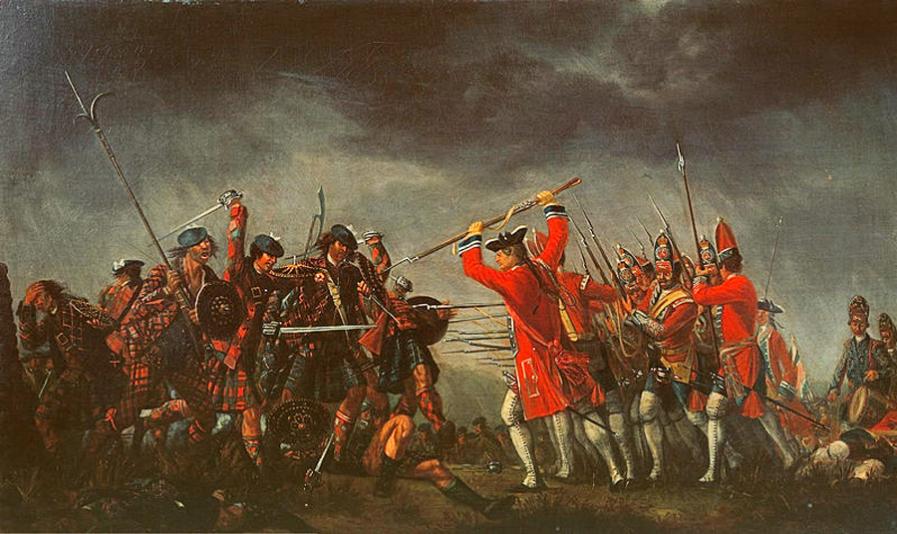A 1730 18th Century Culloden Period Scottish Basket Hilted Sword. In It’s Very Rare Original Leather Scabbard. Pierced ‘Shields and Bullets’ Hilt With High Bun Pommel
An 18th century Scottish basket hilted back-sword of heavy grade combat form with traditional full open basket, with inset oval opening for the holding of reins when on horseback and heart piercings thoughout each panel, and it has a high bun pommel, and original shagreen grip with wire binding. Armourer stamped blade, with either the partially struck running wolf of Solingen or Passau, or, more than likely, the running fox mark of Shotley bridge {not fully struck}.
In its original leather scabbard with old central leather repair, the blade and scabbard are of combat-reduced length. Some few still surviving swords from Culloden have very similarly reduced length blades due to tip adjustment in the 1745 Jacobite rebellion, including the most similar surviving sword of Thomas Milne of Muretoune, supporter of Charles Stuart. The Jacobite rising of 1745, also known as the Forty-five Rebellion or simply the "45", was an attempt by Charles Edward Stuart to regain the British throne for his father, James Francis Edward Stuart. It took place during the War of the Austrian Succession, when the bulk of the British Army was in Europe, and proved to be the last in a series of revolts that began in 1689, with major outbreaks in 1708, 1715 and 1719.
Charles launched the rebellion on 19 August 1745 at Glenfinnan in the Scottish Highlands, capturing Edinburgh and winning the Battle of Prestonpans in September. At a council in October, the Scots agreed to invade England after Charles assured them of substantial support from English Jacobites and a simultaneous French landing in Southern England. On that basis, the Jacobite army entered England in early November, reaching Derby on 4 December, where they decided to turn back.
Similar discussions had taken place at Carlisle, Manchester and Preston and many felt they had gone too far already. The invasion route was chosen to take them through areas considered strongly Jacobite but the promised English support failed to materialise, they were far from home and outnumbered by three government armies, each larger than their own. While the decision was supported by the vast majority, it caused an irretrievable split between the Scots and Charles. Despite victory at Falkirk Muir in January 1746, the Battle of Culloden in April ended the Rebellion and significant backing for the Stuart cause. Charles escaped to France, but was unable to win support for another attempt, and died in Rome in 1788. The Jacobite cause did not entirely disappear after 1746 but the exposure of the key factions' conflicting objectives ended it as a serious threat. Many Scots were disillusioned by Charles' leadership while areas in England that were strongly Jacobite in 1715 like Northumberland and County Durham provided minimal support in 1745. Irish Jacobite societies continued but increasingly reflected opposition to the existing order rather than affection for the Stuarts and were absorbed by the Republican United Irishmen. 27 inch blade 33.5 inches long overall.
Code: 23331
3450.00 GBP










